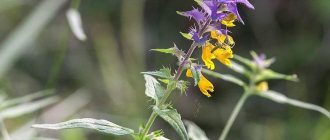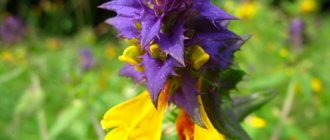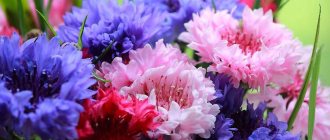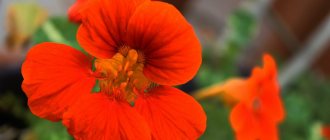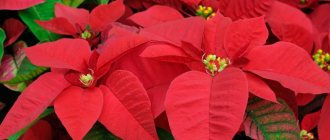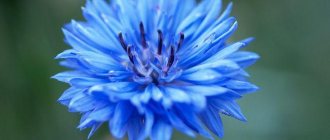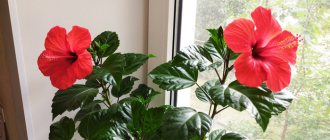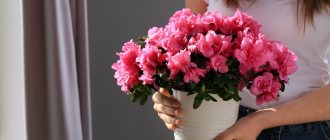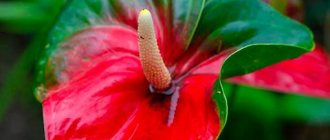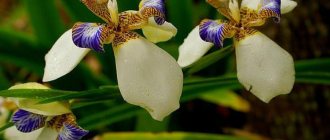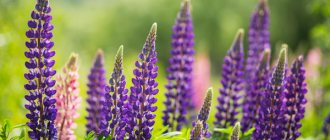Description of the flower
Ivan da Marya is an annual herbaceous plant that grows up to half a meter in height. The root system has specific suckers, thanks to which the flower attaches to other vegetation and lives on its juices. The erect stem, covered with white hairs, is characterized by branches. The ovate-lanceolate leaves are distinguished by their long-pointed shapes.
Each yellow flower is additionally decorated with a bract leaf of blue, violet, crimson or bright lilac color. At the end of the flowering period, which lasts throughout the summer, egg-shaped fruits are formed. Subsequently, the oblong seeds contained in the boxes serve as food for forest inhabitants.
Description
Maryannik attracts attention with its spectacular, two-color brushes, which is not difficult to see from the photograph.
Flowers on short stalks of juicy yellow color are collected in apical inflorescences, similar to a spike-shaped, one-sided brush. They are decorated with jagged, ovoid bracts that are purple at the top and green at the base. The color of the bract can be crimson, bright purple or blue. The flower cup resembles an elongated bell. Inflorescences are formed in the axils of the apical foliage.
The flowering period lasts from May to September. It ends with the formation of a small ovoid fruit. The capsule contains oblong, triangular seeds of a dark brown color. After falling, the seeds have time to germinate, and in October a root system is already formed, which allows it to overwinter under the fallen leaves. After the snow melts, development continues.
Mariannik oak forest
Collection and healing properties of herbs
The entire above-ground part of Ivan da Marya as a medicinal product The collection begins in late spring and ends in September. Initially, the collected material is dried in a well-ventilated area and subsequently stored separately from other herbs. It is also worth remembering that oakberry maryannik very quickly loses its qualities and is suitable for beneficial use during the first ten months.
In medicine, the herb is used as a wound healing and anti-inflammatory agent. The prepared decoction of Ivan da Marya is used for heart and stomach diseases. Adding a medicinal plant to baths helps get rid of rheumatism, eczema and skin tuberculosis.
Effective recipes using the flower:
- A decoction based on oak grass will help get rid of skin rashes, scabies or scrofula. To prepare, dilute 3 tbsp per liter of boiled water. spoons of medicinal herbs. After two hours, the infusion is filtered and added to the bath or used for local rubbing.
- To treat hypertension, heart disease, to get rid of frequent dizziness and epilepsy attacks, the concentration of ingredients changes. In this case, 1 tbsp. l. Ivan da Marya is poured with a glass of boiling water, left for about half an hour and filtered. For effective treatment, drink the decoction twice a day, half a glass.
- The crushed young plant, as well as Ivan da Marya powder, promotes rapid healing of wounds.
Use in folk medicine
In folk medicine, the above-ground parts of this herb are used for the preparation of medicines:
- flowers;
- fruit;
- leaves;
- stems.
Beneficial features
The grass Ivan-da-Marya is a poisonous plant. Its entire above-ground part contains glycosides and alkaloids, including dulcite and aucubine. The seeds are considered very poisonous.
They can cause quite severe poisoning in both people and animals. Therefore, the plant should be used as a medicinal product with caution. Despite this property, the plant has a healing effect for many diseases:
- Thus, its benefits are obvious for diseases of the stomach and gastrointestinal tract, heart (hypertension), as well as for neuralgia and epilepsy.
- It is especially effective to use externally for skin tuberculosis, diathesis, scabies, rheumatism, various rashes, and for washing wounds. Externally, you can use powder from a dried plant, but also juice from a fresh one.
- An infusion of flowers has a calming, sedative, and anticonvulsant effect. Tea from the plant is drunk for scrofula.
Contraindications for use
When faced with the need to use ivan da marya in treatment, it is always important to remember the toxic qualities of the herb . This primarily applies to oral use. Aucubin (glucoside rhinantine), contained in the seeds of the herb, has an irritating effect on the body, which is most often expressed by feelings of weakness, decreased cardiac activity, and constant drowsiness. If these symptoms appear after using drugs based on Ivan da Marya, be sure to consult a doctor.
Landing algorithm
Indoor species of Ivan da Marya are perennials, so pots for planting are chosen with a small amount of capacity. The flower does not like replanting; its thin absorbent roots are easily damaged during handling.
Sequence of work when planting begonias:
- Fill containers 2/3 full with soil.
- Selected tubers are placed on the surface, slightly pressing, but not deepening.
- Keep the containers warm in the light, watering moderately, along the edge of the pot.
- After the sprouts appear, expect them to stretch to 5–8 cm.
- Add soil to normal level, completely covering the roots.
Germination of domestic begonia tubers begins in February. The rapidly growing plant will bloom by early summer. It is convenient to sow marianberry seeds in open ground. The planting of the future flower bed is carried out in late autumn.
You can use seeds collected in the same season for sowing: before the onset of cold weather, the plant will form a root system, and in the spring it will quickly sprout and bloom by May. For successful planting, it is enough to press the seeds into the soil, sprinkled with a thin layer of substrate.
Indoor variety of Ivan da Marya
Mariannik oakberry is a representative of wild vegetation, although this does not prevent avid flower growers from calling other types of indoor plants after Ivan and Marya. One of these varieties is tuberous begonia, also called campanula or “bride and groom”. A home flower differs from its own in many ways:
- appearance. Tuberous begonia blooms almost all year round, and therefore will act as a decoration for any type of interior. The plant is represented by two types of flowers: double, similar to rose buds, and ordinary, consisting of 4-5 petals;
- relate to perennial vegetation;
- Propagated not only by seeds, but also by cuttings.
In its natural form, Ivan-da-Marya is perfect for decorating border compositions made of stone or boulders. But given the fact of the semi-parasite, not many people decide to leave the oak grove in their garden plots.
Preparing for landing
Indoor species of Ivan da Marya can be propagated by cuttings or rooting leaves. But root formation occurs extremely slowly, so tubers are often used for planting. Parts of the rhizome selected for planting must be free of signs of rot, dark spots, and damage. The soil for indoor begonia is loose, with a high peat content.
To plant Ivan da Marya in a garden plot, in a flowerbed, or to obtain medicinal raw materials, the soil is prepared in advance. The area is dug up, adding manure or humus. For rapid growth and abundant flowering of the marianberry, high water permeability of the soil, as well as drainage, will be required. The crop loves moisture, but dies from stagnation of water at the roots.
Due to the parasitism of Ivan da Marya on the roots of any garden crops, the planting site is chosen carefully.
The plant will not affect the growth and development of large shrubs and trees, but will deplete its herbaceous neighbors.
IVAN-DA-MARYA
DESCRIPTION, USEFUL PROPERTIES, APPLICATION AND RECIPES OF PRODUCTS FROM IVAN-DA-MARYA
DESCRIPTION OF IVAN-DA-MARYA Ivan-da-Marya is known as a herbaceous plant, which is often called tricolor violet . It is also known as pansy, brother, earthflower, ball, magpie's eye and triflower. The plant is widespread in the forest zone of the European part. It often grows among bushes, in open spaces, in meadows and as a weed in fields and vegetable gardens. Prefers fertile soils, but is also found on dry, gravelly soils on mountain slopes.
IVAN-DA-MARYA - COLLECTION AND PREPARATION As a medicinal plant, tricolor violet was known in ancient times. Currently, it is well studied and used in medicine. The grass is harvested as a medicinal raw material during the flowering period. It is cut at a short distance from the ground and dried in the shade in the open air. The grass contains saponins, flavone glycosides, rutin, tannins, essential oil, carotene, vitamin C. Along with this, field violet, which has only yellow flowers (grows in Eastern Siberia), is also harvested.
IVAN-DA-MARYA - FOLK TREATMENT Medicines made from violets treat skin rashes, pustular skin diseases, itching, eczema and scrofula. They are also used as a diaphoretic and cough suppressant and for the treatment of bronchitis, acute respiratory infections, rheumatism, gout, and atherosclerosis. In Transbaikalia, tuberculosis, lobar pneumonia and purulent pleurisy are treated with an infusion of variegated violet roots.
IVAN-DA-MARYA - INSTANCE Preparation of the infusion: 2 teaspoons of dry crushed raw materials are poured with a glass of boiling water and filtered after cooling. A glass of infusion is drunk in small portions throughout the day, and if nausea occurs, within two. Read more about the preparation of medicinal infusions in the article “ Healing teas and infusions .”
Recipes in cosmetology
Ivan da Marya is a unique flower that has multiple effects on the skin. The antiseptic effect of the plant is mainly used to treat dermatological pathologies, rashes, furunculosis, and bacterial lesions.
For the whole body
Cleansing and evening out skin tone occurs by taking baths or regularly wiping problem areas. Complex treatment (a combination of external and internal use) gives the most lasting and fastest cosmetic effect. Ivan da Marya extract is added to homemade soap to give it antibacterial properties.
For face
Soak a gauze or cotton swab with a decoction of the green part of Ivan da Marya and wipe the skin where acne appears in the morning and evening. The skin is noticeably clearer after just a week of using the product.
Use a decoction of maryannik to cleanse the skin of the face, rubbing it twice a day.
To combat boils, ulcers and acne, it is permissible to use an alcohol tincture. It can be applied pointwise to the lesions no more than 2 times a day. Undiluted product is not suitable for facial skin.
Antiseptic lotion
The alcohol tincture of Ivan da Marya is diluted with filtered or micellar water in a ratio of 1:3. This composition helps eliminate impurities and disinfects the skin. The lotion can be enriched and flavored with a few drops of any pine or citrus essential oil. It is convenient to use the composition by pouring it into a small spray bottle.
For hair
The strong insecticidal effect of the herb is applicable not only for scabies. The alcohol composition is rubbed into the scalp and distributed along the length of the hair for lice. The product is washed off with undiluted decoction of Ivan da Marya.
The same procedure helps get rid of seborrheic dermatitis. In this case, dandruff is eliminated not only mechanically, but also the cause of the disease (fungus, bacteria) is cured, and the functioning of the sebaceous glands is regulated.
Products based on marianberry treat seborrheic dermatitis
Ivan da Marya is a flower that attracts not only with its unusual beauty, but also with its strong medicinal effect. When using recipes from maryannik, we must not forget that the delicate plant contains plant poisons.
The use of such a drug internally must be justified and performed according to strict indications. A serious overdose can cause irreversible consequences for the heart, liver, and brain, so any negative reaction of the body requires medical intervention.
Ivan da Marya flower: beneficial properties
Ivan da Marya is a name that is used in relation to several completely different types of plants. This name can be given to tricolor violet, meadow sage, periwinkle, and Geneva violet, but most often this name is used to understand oak grass.
It is also called Ivanets, brother and sister, bicolor. This is an annual semi-parasite from the Broomrapaceae family. The plant is highly ornamental, honey-bearing, but poisonous; as a medicinal plant it is used exclusively in folk medicine.
Magical properties of the plant
People have long endowed the grass Ivan-da-Marya with magical properties. So, if you pick a plant on the day of the solstice, the flower will help the one who keeps it with him to escape from pursuit.
Also in Rus' it was believed that a person who keeps a flower with him can ride quickly even on a sick and old horse. Previously, many scouts and messengers carried Ivan-da-Marya in their pockets. It is known that fresh flower juice was given to drink to people who had lost their minds and hearing, reason and memory.
Ivan da Marya flowers, which were collected on Ivan Kupala, were kept in the hut. People believed that the flower protected their home from bad people and evil spirits, and also helped restore relationships between spouses. To protect against thieves, flowers were placed in the corners of the house.
Flower Ivan da Marya: description
Ivan da Marya is a semi-parasitic herbaceous plant with a branched, straight stem 15 to 60 cm high. A parasite on willow, alder, spruce, hazel, and also on herbaceous plants. The stem is covered with white hairs facing downwards. The leaves are opposite, ovate, lanceolate-pointed, heart-shaped at the base, narrowed into a small petiole.
The inflorescence is an apical, sparsely colored spike-shaped raceme. The bracts are opposite, ovate-cordate, pointed with denticles, pubescent at the base and along the veins. The bracts of the lower part of the inflorescence are green, the middle part is blue-violet at the base, the upper part is completely purple.
The calyx is tubular with long-pointed teeth (approximately half the length of the calyx). The flowers are irregular, the pedicels are small, pubescent, facing one direction. The corolla is two-lipped, yellow, with a reddish tube and lower lip.
Legends about the flower
Nature has endowed the Ivan-da-Marya plant with a very bright and contrasting color, which is why there are so many different legends and tales around it.
Each nationality tells its own legend of the appearance of the flower, but in each story there were lovers who, in spite of everything, wanted to be together. So this bright flower became a symbol of fidelity and love. Since ancient times, it was believed that blue is a masculine color and yellow is a feminine color. But it is also not surprising that the name uses the most common Russian names - Ivan and Marya. They could symbolize any couple in love. The two most common legends are:
These are the amazing and interesting stories people wrote about this herb. But the flower became famous not only for its unusual legends, it also became famous for its healing properties.
